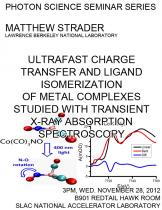Matthew Strader, LBNL
The chemistry of transition metal complexes in solution has broad applicability to a number of fields, including catalysis, charge carrier generation and biological systems. Pump-probe spectroscopy has long enjoyed success in identifying ultrafast reaction mechanisms and intermediate states involved in transition metal complex photochemistry. The incorporation of ultrafast, x-ray, probe pulses from modern light sources has enabled the characterization of metal complex chemistry using x-ray absorption spectroscopy. Metal K-edge XANES yields information on the valency of intermediate metal center, while L-edge XANES provides complementary information on the electronic occupancy and hybridization of the metal d-orbitals on the picosecond timescale. Transient EXAFS can be used to precisely identify the molecular geometry of the ligand cage. Specifically, I will present my research using Beamline 6.0.1/6.0.2 at the Advanced Light Source to indentify key intermediate states in charge transfer reactions (iron and ruthenium bipyridyls) and ligand isomerization reactions (cobalt nitrosyl) upon visible photoexcitation.





